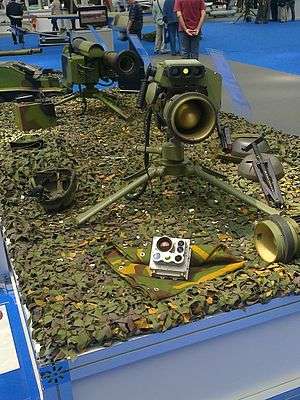Bumbar
| BUMBAR | |
|---|---|
|
BUMBAR at display | |
| Type | Anti-tank missile |
| Place of origin | Serbia |
| Service history | |
| In service | 2012 |
| Production history | |
| Designer | Military Technical Institute Belgrade |
| Designed | 2005 |
| Manufacturer | Krušik Valjevo |
| Number built | 12 station in final stage of production(100 missiles) + 3 prototypes built |
| Specifications | |
| Weight |
Missile: 10kg Launch tube: 2 kg Firing post: 4 kg Tripod: 2 kg Total: 18 kg |
| Length | 0.9 m (35 in) |
| Diameter | 136 mm (5.4 in) |
| Warhead | tandem, shaped charge |
|
| |
Operational range |
60 m-600 m (1000 m under development) |
| Speed | 18 m/s at launch - 245 m/s at maximum |
Guidance system | SACLOS wire-guided |
Launch platform | Individual, Vehicle |
The BUMBAR (English: Bumble Bee) is a short-range portable anti-tank missile system developed and produced by Serbia.
Description
Bumbar (English: Bumble Bee) is an anti-armor (tank) weapon from Serbia. The Bumbar is a wire guided, man-portable, short-ranged missile system for use against ground targets. The missile has a soft launch capability - the main motor firing after the missile has left the launcher, which allows for the missile to be fired from confined spaces, which is a necessity in urban warfare. During the flight rocket is maneuvered by unique system of thrust vectoring. The missile is propelled by two main rocket motor exhaust vanes located at mid body. As the missile rotates the launch units send signals commanding the correction by one of the two vanes to move against the missile motors thrust. For example if the missile has to move to the left, the right thrust vector vane will actuate at the correct time. It is protected against electronic countermeasures through: "Use of CCD matrix sensors, fast image processing computer and robust missile tracer recognition algorithm."[1]
Its general design is similar to the French/Canadian ERYX MBDA anti-tank missile.[2] However MBDA has never supplied Serbia or the former Yugoslavia with technical information regarding the Eryx.[3] All key components of the Bumbar system are indigenously developed by VTI - Military Technical Institute Belgrade Serbia.
General information
- Time of flight to target at 600 m: 4.6 s
- Warhead penetration: over 1000 mm RHA behind ERA
- Range: up to 600 m
- Weapon length in travelling position: 1164 mm
- Capable of firing from confined spaces
- Night firing capability
- Mass of missile in transporting/launching tube: 14 kg
- Secondary warhead caliber: 55 mm
- LC axis superelevation angle: 10°
See also
References
- ↑ "BUMBAR (Bumble Bee) short-range anti-tank missile (Serbia), Anti-tank weapons". Jane's Information Group. 2008-12-29. Retrieved 2009-10-04.
- ↑ Aleksandar, Kis. "Bumbar (Bumble Bee)". FAS Military Analysis Network. Retrieved 2008-12-20.
- ↑ "BUMBAR (Bumble Bee) short-range anti-tank missile (Serbia), Anti-tank weapons". Jane's Information Group. 2008-12-29. Retrieved 2009-10-04.

